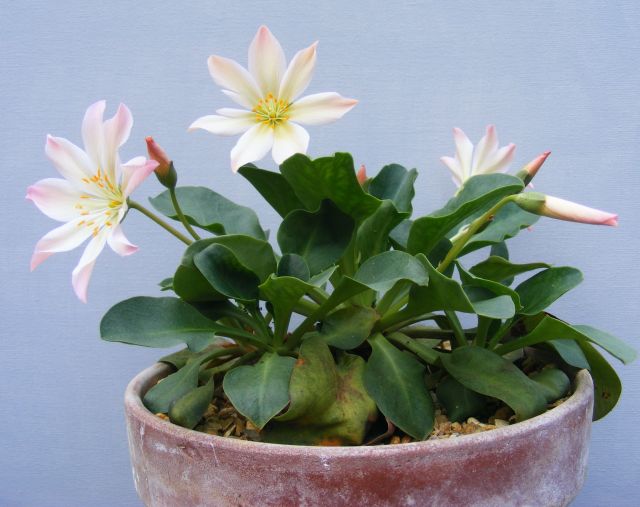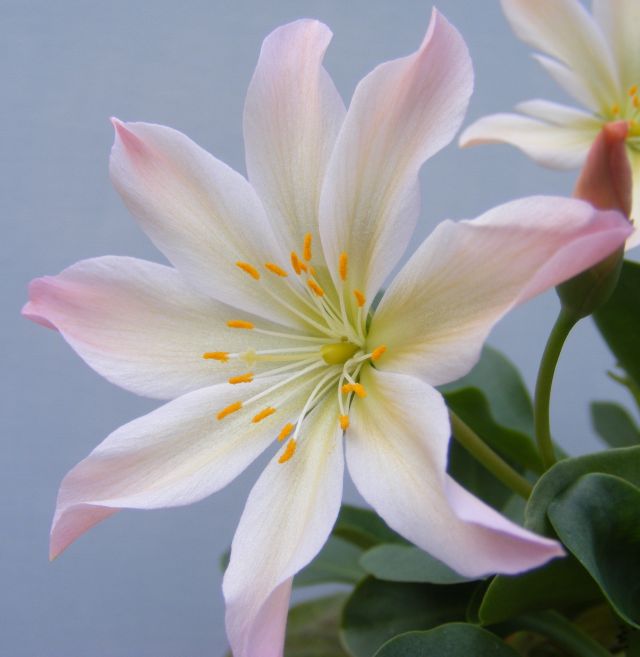They can call them Cistanthe if they want to but to me they have always been Lewisias and they always will be. So there, put that in your pipe and smoke it whoever you are ;D
My first one of the season, Lewisia tweedyi, this plant grown from seed quite a few years ago now. Around four years ago I had a very bad Lewisia year and thought I might loose the plant but it got a good haircut, lost an arm or two, and now it's looking qhite like it's old self again.



Comments
Trond Hoy
Re: Lewisia-2012
Thu, 04/12/2012 - 12:28pmI don't smoke, thank you and you can name that plant whatever you want - it is as nice as any plant can be! I have always wanted to grow more Lewisias but my climate wont allow that I am afraid - not outdoors anyway :(
Richard T. Rodich
Re: Lewisia-2012
Thu, 04/12/2012 - 6:28pmA very lovely shade of lavender near the tips, David. Congrats!
A rose by any other name would smell as sweet.
--------William Shakespear
Gene Mirro (not verified)
Re: Lewisia-2012
Sat, 04/28/2012 - 12:48pmLewisia tweedyi growing in a north-facing retaining wall:
The soil around the roots is sandy loam, but it is surrounded by heavy clay loam.
Edit: my best Lewisia tweedyi this year:
Gene Mirro (not verified)
Re: Lewisia-2012
Sat, 04/28/2012 - 1:18pmLewisia leana, grown from a plant from Jane McGary:
Grown in a cool greenhouse, in fairly gritty mix.
Trond Hoy
Re: Lewisia-2012
Sat, 04/28/2012 - 1:53pmThey seem to do well in a north facing wall! I am planning a new bed and are looking for plants to sit at the north facing side. How do they take wet winters?
Gene Mirro (not verified)
Re: Lewisia-2012
Sat, 04/28/2012 - 3:20pmThe winters here are very wet and between 0 - 10C most of the time. If the roots are surrounded by coarse, sandy soil, they seem to be happy.
deesen (not verified)
Re: Lewisia-2012
Sun, 04/29/2012 - 1:50amThey look very happy in your wall Gene. I've never tried them ouside but I don't think they would like my wet climate. I like you L. leana too, it's a plant I've tried a couple of times and have lost it each time. Not an easy plant to source in the UK.
Couple of pictures below of my Lewisia tweedyi 'Rosea'
Tim Ingram (not verified)
Re: Lewisia-2012
Sun, 04/29/2012 - 2:25amI never would have thought that Lewisia tweedyi (like David I shall always know it by this name) could grow outside in our climate. However, after listening to Peter Korn describing it growing on his sand beds in Sweden with high rainfall it does seem more possible. I think the success comes from the very large scale of the beds, and coarse gravel topdressing, giving really perfect drainage. But I've never known any record of growing it in the UK in a vertical wall like Gene does - wonderful sight.
Palustris (not verified)
Re: Lewisia-2012
Sun, 04/29/2012 - 2:31amMy reading of the material suggests that Cistanthe tweedyi is the synonym for L. tweedyi not the other way round, so Lewisia it is and so it remains until they get DNA testing of course.
The only one which survives outside here is Lewisia columbiana and that even managed to survive being hauled out by a blackbird a couple of seasons ago. Not in flower yet, but the rosette looks ok.
deesen (not verified)
Re: Lewisia-2012
Wed, 05/16/2012 - 11:13amThe smallest of my small Lewisia collection and looking lost in a 3" pot-Lewisia pygmaea
Richard T. Rodich
Re: Lewisia-2012
Wed, 05/16/2012 - 3:31pmA passable pic of one of mine, with a little variation from yours, David. I still have it because it persists by seeding itself, but L. pygmaea is not high on my desirable list. The species is just not that interesting to me.